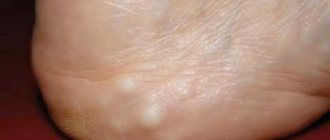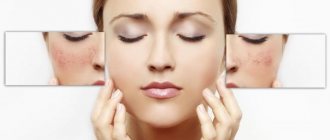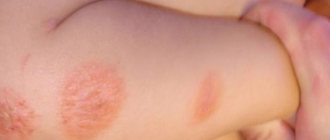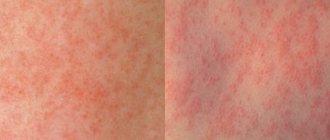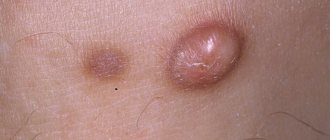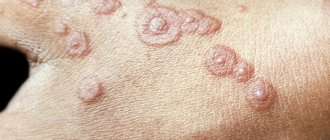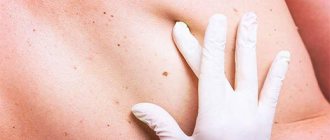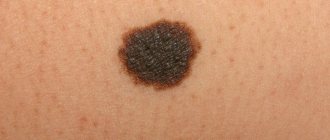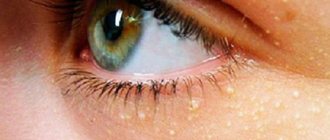What is rosacea?
Why do blood vessels on the face become noticeable? This occurs due to a violation of blood microcirculation, when the walls of small vessels (capillaries) lose their elasticity and, once expanded, can no longer narrow. In addition, the capillary walls become brittle. This manifests itself first by the appearance of areas of even redness on the cheeks, on the wings of the nose, on the forehead or chin, and then a clearly visible vascular network forms in the affected areas.
If the pathological expansion concerns single small vessels, this does not affect the nutrition of the skin and is considered only a cosmetic defect. If the process involves large areas of the skin with damage to blood vessels in its deep layers, this is already a disease, a violation of the skin blood supply. The nutrition of the facial skin deteriorates, it becomes rough, flabby, and wrinkled. The problem requires treatment.
Cuperosis can be an independent disease or a sign of other diseases (intestines, liver, stomach, etc.).
Couperosis occurs more often in women than in men, and mainly thin, light blonde skin is susceptible to capillary dilation.
Why does this happen
This is a classic sign of liver cirrhosis. In this case, white areas may appear on the nails. If a combination of these two points is observed, it is most likely cirrhosis. Also, sometimes there is an unpleasant odor from the mouth. The main cause of cirrhosis is fatty liver disease.
With liver problems, both women and men begin to produce estrogens (female sex hormones) in excess. This leads to the appearance of spider veins on the skin.
These appear not only on the face, but also in other areas. And in such a situation, it is absolutely not enough to remove such formations. We need to fight the root cause.
Sometimes this is a growth of blood vessels, which is called a hemangioma. This is an abnormal growth in a specific area caused by various factors in the functioning of the cardiovascular system. Sometimes this happens due to stress, but this is only an indirect factor. The main reason is disruptions in the cardiovascular system.
Often the cause of hemangiomas is arrhythmia and thrombus formation. Somewhere the blood flows more slowly, and the uneven functioning of the heart aggravates an already difficult situation. As a result, in some areas, the proliferation of vessels in the form of asterisks occurs. Often happens on the face. Hemangioma is one of the common causes in children.
Smoking also causes dilated blood vessels. The same applies to alcoholic drinks. This is also facilitated by aggressive exposure to sunlight. In such cases, such processes often occur en masse. A person does not have a separate red dot as with a hemangioma, but a whole network of vessels is visible.
Causes
The development of rosacea is associated with weakness and low elasticity of the vascular wall. Such vascular features can be congenital or acquired. They arise for the following main reasons:
- genetic defects;
- hereditary predisposition;
- sclerotic changes in the walls of blood vessels;
- damage to the vascular wall as a result of autoimmune processes (for example, rheumatism, systemic lupus erythematosus, etc.).
Congenital rosacea
Genetically determined telangiectasias appear in the following diseases:
- Osler-Rendu disease with constant vascular bleeding;
- immunodeficiency in Louis-Bar syndrome;
- Sturge-Weber disease, or encephalotrigeminal angiomatosis.
Cuperosis in these ailments is not the main, but a concomitant syndrome, but it is impossible to remove its manifestations, since it is impossible to change the patient’s genetic code. Only temporary measures are used to alleviate these manifestations.
Acquired rosacea
The weakness of the vascular wall in the case of acquired rosacea is determined by a combination of certain hereditary factors with the influence of provoking circumstances, which are very diverse.
Causes of the disease
The causes of rosacea on the face can be external and internal.
External reasons include:
- Sudden temperature changes. They negatively affect blood vessels and primarily affect the skin on exposed areas of the body. Telangiectasias appear in these places, that is, on the face. Frost, wind, and heat affect those capillaries whose walls have lost their elasticity. Visiting a bathhouse, solarium, swimming in cold water, prolonged exposure to the sun are factors that negatively affect blood vessels.
- Cosmetic procedures. Rubbing the skin with an ice cube, steam baths, mechanical peeling, clay masks, alcohol sanitary napkins and cosmetics - all this can cause the appearance of an expanded mesh. Women who do not protect their skin from frost and ultraviolet radiation risk getting a red complexion and telangiectasias.
Internal factors:
- Hormonal changes. Fluctuations in estrogen levels in women during pregnancy and menopause, taking contraceptives and other hormonal drugs cause microcirculation disturbances. Sometimes rosacea appears in diseases of the ovaries. At the first signs of pathology, a consultation with a gynecologist and endocrinologist is required.
- Hereditary predisposition. Cuperosis is a disease similar to varicose veins. In both cases, the stability of the vascular membrane and the strength of the connection of endothelial cells are disrupted, which leads to dilation of blood vessels and loss of elasticity. If close relatives have had these diseases, the person is at risk.
- Unhealthy Lifestyle. Drinking alcohol, smoking, overeating, eating spicy and pickled foods affects the condition of the capillaries. Alcohol is especially dangerous in this regard. Quickly absorbed in the stomach, it enters the bloodstream and first causes a sharp spasm, and then dilation of the blood vessels of the face. Such fluctuations can trigger the development of rosacea.
- Diseases of internal organs. Liver pathology (fatty changes, hepatitis, cirrhosis), intestinal diseases, gastritis, dysbacteriosis, hypertension are possible causes of rosacea.
- Stress, depression, emotional tension. Prolonged negative emotions cause an increase in the hormone norepinephrine, which leads to hypertension and dilation of capillaries.
How to get rid of rosacea on the face? It is necessary to treat diseases of the internal organs; without this, any cosmetic product will be useless. If the doctor does not find any abnormalities, then the person should reconsider their lifestyle, give up bad habits, analyze their menu, and engage in available sports (Pilates, swimming, cycling).
Provoking factors
Skin prone to the development of rosacea can have a healthy appearance and natural color for a long time if the body is not exposed to factors that contribute to the implementation of a hereditary predisposition. These factors include:
- Diseases of the digestive tract (intestines, stomach, liver); hypertonic disease; dysfunction of the gonads; allergic reactions; pulmonary and heart failure; vegetative-vascular dystonia.
- Decreased immunity.
- Frequent stressful situations, depression, when blood pressure in the capillaries increases.
- Hormonal changes during pregnancy or menopause; treatment with hormonal drugs; taking hormonal contraceptives.
- Sudden changes in ambient temperature (in a bathhouse, sauna, when working in “hot” shops, during cosmetic procedures, etc.).
- Frostbite or sunburn of the skin; excessive insolation due to excessive enthusiasm for visiting the beach or solarium.
- Living in an aggressive, sharply continental climate with strong winds, winter frosts and summer heat, with low air humidity.
- Smoking and alcohol abuse - both nicotine and alcohol cause spasm of facial vessels with subsequent dilation. Red wine especially strongly provokes the development of rosacea.
- Frequent consumption of dishes with spicy seasonings, marinades, strong broths, too hot food, chocolate, coffee.
In the absence of provoking factors, rosacea may never appear, despite the fact that the patient’s heredity is burdened.
What are spider veins
“Cooperosis occurs due to poor circulation. The blood vessels dilate and blood stagnates. As a result, the load on the capillaries increases, which leads to thinning of their walls. The capillaries are deformed and form a mesh visible on the skin. At the same time, the skin becomes sensitive, prone to dryness and redness.”
The expansion of single capillaries on the face is rosacea. © Getty Images
Symptoms and stages
Single telangiectasias are not always a sign of rosacea. They may be the result of a severe runny nose or hypothermia of the skin in severe frost. In this case, the affected areas do not grow, and gradual progression of the pathology is not observed. This phenomenon is called false rosacea, in contrast to true rosacea.
The symptoms of true rosacea are very characteristic: against the background of a healthy, natural complexion, a relief network of red-violet vascular veins, usually located on the cheeks or nose, stands out clearly. In addition, spider veins (nodules) appear on the face. They are formed as a result of expansion or rupture of capillaries and tend to grow: initially not exceeding 0.5 mm in diameter, the stars eventually double in size and become noticeable from afar.
This clinical picture does not develop all at once, but gradually, gradually. Accordingly, several stages are distinguished in the development of the disease.
First stage
It is characterized not so much by external changes as by the appearance of unpleasant sensations: the skin of the face becomes dry and overly sensitive. Every touch – when washing your face, applying makeup, etc. – accompanied by a feeling of burning, tingling, and mild itching. The same discomfort is caused by a change in air temperature, for example, when leaving a warm room to go outside.
Sometimes there is a rush of blood to the face, a feeling of heat, and the whole face turns red, but the redness quickly disappears: the wall of the capillaries is still quite elastic, and after expansion the vessel narrows again. Manifestations of conjunctivitis are not uncommon at this stage.
Second stage
Redness of the skin on the face occurs more and more often and lasts longer, it is localized in certain areas - most often in the area of the cheeks and wings of the nose. The fragility of capillaries increases, and isolated vessels and stars become noticeable against the background of red spots. Dilated vessels can no longer return to normal. Gradually, a semblance of a vascular network is formed on the face.
If left untreated, the symptoms progress: the redness of the skin becomes persistent and covers larger areas, not limited to the face. The network of vessels acquires relief and brightness, it is noticeable even from a distance; the overall complexion becomes an unhealthy red.
Areas of skin redness also appear on the legs, and sometimes on the back. At this stage, the development of varicose veins is possible.
Third stage
The disease progresses rapidly, and deeper vessels are involved in the process. Blood microcirculation is disrupted, which leads to deterioration of skin nutrition. Inflammatory diseases occur, and against the background of red skin with a pronounced vascular network, single pustules or entire groups of them appear.
Facial skin responds to nutritional deficiency by rapid aging. Cuperosis enters the fourth stage.
Fourth stage
The skin of the face becomes dry and thin; areas of peeling appear on it. The red complexion gives way to a grayish pallor. Against this background, the capillary network already has a blue-purple tint.
What is done with an extensive network of enlarged vessels?
Sometimes a person has a widespread problem in which enlarged blood vessels are spread throughout the face. They are visible even with the naked eye. These are red threads that are especially visible on pale skin.
In such a situation, a laser is also used. Namely, laser sealing of blood vessels. This is done using a neodymium laser.
If the vessels are not on the surface, other equipment is required. In such a situation, IPL photo systems are used. Such photo radiation is selectively absorbed by the oxyhemoglobin of the vessel. Thanks to this, it is possible to remove rather deep-lying diseased vessels.
Removal of spider veins on the face varies in time. If this is an extensive network of problem areas, then the duration of the procedure starts from half an hour. This will leave some redness, which should ideally go away within a few hours. If this does not go away quickly, the doctor will prescribe a topical ointment.
Diagnostics
The diagnosis of rosacea is made by a cosmetologist; To do this, he just needs to examine the patient. The bright characteristic blush with a visible network of blood vessels cannot be confused with anything else.
However, a cosmetologist will not be able to determine whether rosacea in this case is an independent disease or a symptom accompanying another disease. Therefore, the patient should undergo consultation with other specialists: phlebologist, dermatologist, endocrinologist, neurologist, gastroenterologist, and women also need an examination by a gynecologist.
In addition, examination is prescribed:
- general blood and urine tests;
- blood test for thyroid hormones, testosterone and progesterone;
- An ultrasound of the thyroid gland or other organ is performed if a specific disease is suspected.
How it appears on the skin
The occurrence of the disease is caused by a violation of blood microcirculation in the layers of the epidermis, as a result of which constant stagnation is observed in small blood vessels located in the skin. All this leads to fragility, destruction of capillaries that are located close to the surface of the skin, and, as a result, to hyperemia and the formation of vascular mesh on the face.
Cuperosis is often accompanied by severe dryness of the epidermis, which provokes the early appearance of wrinkles. For this reason, it is very important to begin timely treatment of this condition in order to prevent premature aging of the skin, especially when it comes to the fair sex.
Women with fair skin, characterized by increased sensitivity to irritating external factors, are most susceptible to rosacea. Most often, this phenomenon occurs on the wings of the nose, on the skin of the cheeks and cheekbones. At the same time, redness caused by rosacea contrasts sharply with healthy areas of the epidermis, worsening the appearance and causing psychological discomfort.
When rosacea appears in men, this phenomenon is often associated with alcohol abuse, but in most cases liver pathologies are the culprits.
Reasons for the development of rosacea
The most basic reason for the occurrence and development of rosacea is a hereditary predisposition to the weakness and fragility of blood vessels. But there are many other factors that could act as reasons for the manifestation of the problem in question:
- Abuse of alcoholic beverages, since drinking alcohol has a dilating effect on all blood vessels. As a result of such pressure, the capillaries on the face cannot withstand and burst, contributing to the formation of the characteristic vascular network on the face.
- Smoking cigarettes, as nicotine has a destructive effect on the walls of blood vessels.
- Sudden temperature changes, for example, contrasting washing or wiping the face with ice cubes provoke the destruction of small capillaries located in the layers of the epidermis. This also includes climate change, frequent visits to steam rooms and baths, etc.
- Ultraviolet radiation often provokes the appearance of rosacea on the skin.
- The expansion of capillaries is also facilitated by frequent consumption of spicy seasonings and excessively hot dishes.
- Frequent stressful situations in some people provoke an increase in blood pressure, which often causes stress on small blood vessels.
- Pathology can occur due to chapping of the face, hypothermia in the cold.
- Sudden weight loss or, conversely, weight gain contributes to the load on blood vessels.
- Problems with blood pressure, tendency to sudden surges in pressure.
- Weakened immunity causes many problems in the body, and rosacea is no exception.
- Elderly people are more likely to experience symptoms of rosacea.
- Pathological processes in some internal organs, for example, in the liver.
- Inflammatory process in the nasal sinuses.
- Concomitant diseases such as rheumatism, lupus erythematosus, disruptions in the hormonal system, hypertension, heart failure, atherosclerosis, disorders of the digestive system, endocrine pathologies, etc.
- Pregnancy, menopause, treatment with hormonal drugs.
- Avitaminosis.
- The presence of rosacea on the face.
- Improper skin care, drying out of the epidermis due to incorrectly selected cosmetics, frequent use of scrubs and alcohol-based lotions.
Treatment of spider veins on the face will be most effective if the main causes of its occurrence are identified and eliminated. To do this, you need to undergo a full examination by several specialists at the same time. First of all, a consultation with a highly qualified phlebologist is necessary, who will determine the possible causes of the pathology and refer the patient to all the required diagnostic procedures.
There are several congenital diseases that result in the development of rosacea. These are very serious pathological conditions that are incurable, and if they are present, preventive measures are required to prevent the formation of spider veins for life. We are talking about diseases such as encephalotrigeminal angiomatosis, or capillary tumor, as well as constant pathological bleeding of blood vessels or Rendu-Osler disease, and immunodeficiency syndrome.
Stages
Symptoms of this pathology with a small number of dilated capillaries may not appear in any way, but large areas of damage often indicate many damaged vessels. Based on the degree of damage, there are three stages of the problem under consideration:
- The first stage or erythrosis is characterized by a tendency to redness of the facial skin. This can occur under the influence of any irritants, for example, a sharp change in temperature or ingestion of spicy-tasting foods. In some people, facial redness is accompanied by increased sensitivity of the epidermis, tingling or itching sensation. This condition may be fleeting, but it can also last for several hours, after which the skin acquires a normal shade. And this is due to the fact that the vessels at this stage have not yet lost their elasticity.
- At the second stage, a clear vascular pattern can already be seen on the face, since excessive load on the blood vessels leads to their destruction and the appearance of symptoms of rosacea on the face. Typically, it is at this stage that patients turn to cosmetologists or doctors for help.
- The third stage of the disease is characterized by chronic circulatory disorders, which lead to serious congestion in the layers of the skin, a more pronounced vascular pattern and a significant deterioration in complexion. Due to problems with blood microcirculation, there is a lack of nutrients and moisture, which, first of all, always affects the condition of the facial skin. This stage of rosacea develops due to lack of treatment for several decades after the first signs of this cosmetic defect appear.
Many people confuse the third stage of rosacea and another dermatological disease called rosacea. You should know that these are two completely different diseases, despite the external similarity of symptoms, and they have different causes of development.
It is very important to carry out timely treatment of the pathology, but only after establishing the exact causes of its occurrence. If the provoking factors are internal disorders in the body, then local therapy alone will not give the expected effect, or the result will be temporary. The use of drugs for the local treatment of rosacea should be in combination with the use of medications, the action of which is aimed at eliminating the symptoms of the underlying disease, which is the cause of the vascular pattern in various parts of the epidermis.
If the culprits of rosacea are exclusively external factors (improper care or very thin skin), then it is quite possible to cope with the signs of the problem in question on your own, or with the help of a cosmetologist.
Couperosis and rosacea
Cuperosis in its clinical symptoms is very similar to another skin disease, rosacea (rosacea). In the early stages, these diseases can be confused by seeing the characteristic redness of the face with spider veins. However, rosacea is a broader concept than rosacea. This is a chronic disease, the initial stage of which also includes rosacea, which in this case is only a symptom and not an independent disease.
The main differences between rosacea and rosacea (except for acne vulgaris itself):
- Heterogeneity of vascular dilations on the face.
- Symptoms can completely disappear spontaneously or under the influence of drug treatment, which never happens with rosacea. Drug therapy only slightly weakens the manifestations of rosacea.
- The final stage of rosacea is characterized by roughening of the skin and its hypertrophy; deformation in the nasal area (“pineal” nose).
Treatment of liver cirrhosis
It is important to understand that you should hurry before bleeding starts. A third of patients die from bleeding that began immediately after asymptomatic cirrhosis.
Now they are using effective modern treatment technology, which can cope with cirrhosis that is not yet too far advanced. Unfortunately, this is not yet widespread everywhere.
The technique is called TIPS surgery (trans-regular intrahepatic porto-caval stenting). A special conductor is used, with which the surgeon changes the blood flow in the liver so that the liver is relieved of excess blood flow. This is done under X-ray control. In the Russian Federation, this is done in at least one hospital in Moscow (named after Pletnev).
The task of doctors is to reduce the pressure in the liver so that there is no rupture and fluid does not accumulate in the abdomen. Local anesthesia is administered and the patient is conscious. The surgeon's task is to connect the hepatic vein with the portal vein. This ultimately helps relieve the liver from excessive blood pressure.
The blood bypasses the liver, passing through the shunt. As a result, it goes directly to the heart. The shunt will last the rest of your life, but it is advisable to undergo a liver transplant if possible. It is difficult to say how a person without such an operation will feel. However, at least the person will live to see the transplant.
As for spider veins, they are not the first thing they fight with, but they do not leave them without attention. After all, they sometimes burst and severe bleeding occurs. They are treated in a similar way to how hemangiomas are treated.
Treatment
Treatment of rosacea should be comprehensive, aimed primarily at eliminating the cause of the disease, and secondarily at removing external manifestations. If, during the examination, any chronic pathology is revealed in the patient that provoked the development of rosacea, then treatment is carried out by a doctor of the corresponding narrow specialty.
If no concomitant diseases are found, treatment is carried out by a dermatologist and cosmetologist.
Drug treatment
In the treatment of rosacea, drugs are used that improve the condition of blood vessels:
- Troxevasin – increases the elasticity of the vascular wall, reduces its fragility and permeability. The composition of the medicine includes rutin and ascorbic acid. Troxevasin is widely known as an ointment for rosacea, but it is also available in tablet form. The drug is prescribed orally when telangiectasias spread to large areas of the skin.
- Isoflavonoids (rutin, vitamin E, ginkgo biloba, etc.) – help remove toxic substances from the cells of the vascular wall.
- Ascorutin (rutin in combination with ascorbic acid) – strengthens the capillary wall.
- Adrenaline - used as a vasoconstrictor, reducing the brightness of the vascular network and reddened areas of the skin on the face.
Salon treatments for rosacea
Treatments offered by beauty salons for rosacea are few in number, since caring for sensitive skin must be extremely careful. Deep cleaning by vaporization and mechanical peeling is excluded.
The following gentle procedures are possible:
Ultrasonic skin cleansing. Under the influence of ultrasonic vibrations, dead skin cells and comedones (black and whiteheads) are gently removed, and cellular metabolism is activated.
Galvanization (disincrustation). The method involves cleansing the skin using galvanic current and saline solution.
Chemical peeling. The procedure boils down to removing the top layer of skin along with diseased capillaries by exposure to one or another acid. The renewed layer of skin has firmness and elasticity; the vessels located in it do not show a tendency to expand for some time. Of all types of chemical peeling for rosacea, lactic, glycolic, almond, phytic, retinoic (using appropriate acids) are used.
Enzyme peeling. Gentle cleansing of the skin using plant, animal or bacterial enzymes (papain, bromelain, sorbain, trypsin, pepsin, lysozyme, subtilisin or travase). Enzymes narrow enlarged pores, increase the level of skin hydration, reduce the severity of the vascular network and the intensity of redness.
Aquapeeling (gas-liquid dermabrasion). A hardware peeling method, when the top layer of skin is “washed off” with a thin stream of oxygen mixed with saline or other medicinal composition. The mixture is supplied under high pressure.
Skin nutrition. Skin with manifestations of rosacea especially needs additional nutrition. In beauty salons, highly concentrated vitamin complexes (with vitamins C, E, K) are applied to the facial skin; moisturizing oils (grape seed oil), creams with plant extracts.
However, the possibility of using even these procedures depends on the severity and prevalence of rosacea. Permission to perform a particular technique must be given by a cosmetologist.
Cosmetological methods for treating rosacea
Modern cosmetological techniques used for rosacea are aimed at destroying and removing deformed capillaries that weave into a mesh on the face. In this case, the blood flow is directed to the reserve vessels, and circulatory disturbances do not occur. Several methods of vascular correction have been developed:
Electrocoagulation
The dilated vessel is destroyed by an electrical impulse, which is passed through a thin needle or through a hair electrode (diathermocoagulation). This manipulation is carried out once a week and, if a large area of skin is affected by rosacea, the course of treatment is delayed for a long time. Therefore, the technique is used mainly to remove single telangiectasias. The formation of small scars and age spots is possible.
Laser therapy
There are several options for treating rosacea using different types of laser (argon, hydrocarbon, etc.). In any case, the laser beam heats the affected vessel to 60°-70°, and its walls are “soldered together.” The technique is used to treat large areas with pronounced vascular networks. The disadvantage is the rather high probability of side effects: the formation of scars, burns, hematomas, pigment spots.
Phototherapy
The affected area is treated with high intensity light pulses. The technique is gentler than laser therapy and can be used to treat large collections of dilated capillaries and spider veins. Improves the overall condition of the skin, smoothes wrinkles, removes age spots.
Ozone therapy
An oxygen-ozone mixture is injected into the lumen of the vessel through a thin needle. Oxygen saturation helps restore the elasticity of the vascular wall. The deformation of the capillaries disappears, and the stars dissolve without leaving any marks on the skin. A safe and effective method, unfortunately, applicable only for the removal of single stars and vessels.
Sclerotherapy
The method consists of gluing the walls of the affected vessels with a special adhesive substance injected through a needle. It is used when sufficiently large vessels are affected, at any stage of the disease, and gives a stable, long-lasting effect, sometimes even lifelong.
Mesotherapy
In the middle layer of the skin (dermis), i.e. to a depth of 1.5-3.9 mm, so-called therapeutic cocktails are administered by injection. They include amino acids, herbal extracts, minerals, nucleic acids, and vitamins. The composition of the cocktail is individual for each patient. Such injections improve blood microcirculation, and, consequently, its regenerative ability. Manifestations of rosacea fade and sometimes disappear completely.
Elos rejuvenation
This is the name of the technique of simultaneous exposure of the skin to light, laser and radio radiation. As a result, the affected capillaries thrombose and turn pale; the skin lightens due to the destruction of melanin pigment; The production of elastin, collagen and hyaluronic acid is enhanced. The skin texture is evened out, its firmness and elasticity increases.
Treatment of rosacea at home
At home, treating rosacea means, first of all, proper facial skin care.
The use of cosmetics must be approached with great caution. Do not use alcohol-containing lotions and tonics, scrubs, or masks that form a film. The use of cosmetics containing menthol, mint, cloves, aloe, honey, and eucalyptus is contraindicated. Cosmetic clay is also harmful for rosacea.
Instead of soap, you should use cosmetic milk or cream to cleanse your face.
Medicinal products (ointments, creams) should be applied to the skin carefully, not with rubbing, but with light tapping movements.
When washing, you should use neither cold nor hot, but only warm water. Rubbing your skin with an ice cube is prohibited!
After water procedures, there is no need to wipe your face; Just blot it with a towel made of soft, natural fabric.
Steam inhalations, manual facial cleansing, and the use of mechanical massagers are contraindicated.
No matter how much you like going to the bathhouse or sauna, you will have to give them up, just like visiting a solarium. You should also avoid direct sunlight on your face - wear wide-brimmed hats and use sunscreen cosmetics.
The condition of blood vessels improves significantly with regular intake of vitamin and mineral complexes.
At home, you can apply pharmacy collagen masks to your face.
Swimming, Pilates, and yoga strengthen the vascular wall; walking and cycling.
In addition, at home you can use folk remedies for rosacea using medicinal herbs and other plant materials.
- Chamomile decoction compress: 1 tbsp. Brew a spoonful of chamomile flowers with 200 ml of boiling water, let cool, strain. Soak a piece of cotton cloth in the broth and apply it for 10-15 minutes. on problem areas of the face.
- Grated potato mask: grate fresh peeled potatoes on a fine grater or chop with a blender. Apply the resulting mass to your face. In 10 minutes. rinse off using chamomile infusion. Effectively reduces facial redness.
- Starch mask with berries: 1 teaspoon of starch mixed with 2 tablespoons. spoons of mashed raspberries or strawberries, sea buckthorn, lingonberries. The mixture is applied for 20 minutes. on cleansed facial skin. Then wash off with warm water or chamomile decoction.
Preventive measures
A healthy lifestyle is not a guarantee, but it is significant insurance against such formations.
In this context, special attention should be paid to:
- stress resistance;
- heart function;
- drinking regime and nutritional culture.
If red threads are detected under the epithelium on the face, it is advisable to contact the clinic as soon as possible. The thinner the vessels are, the easier it will be to deal with them. And over time, they only grow.
Learning not to worry, walking at least five kilometers a day and watching your weight is what to do to prevent problems. If a person lives in a northern region where there are not enough vitamins, it is advisable to take vitamin-mineral complexes periodically. These, by the way, will not harm others.
It is important to move more, because otherwise blood stagnation occurs. And this applies not only to those who have a sedentary job. People who regularly spend a lot of time on their feet, but stand rather than walk, are at just as much risk.
For example, these are sales consultants who have to spend ten hours on their feet without sitting down even once. So it’s worth taking a closer look at your profession and minimizing the negative consequences.
Diet
The diet for rosacea comes down to increasing the daily diet of foods high in vitamins - vegetables, berries, fruits, as well as cereals (buckwheat, oatmeal and corn).
Especially healthy are dishes made from Jerusalem artichoke, carrots, bell peppers, broccoli, parsley, asparagus, onions, and spinach. Sauerkraut, black and red currants, apples, lingonberries, blueberries are welcome.
Milk, kefir, cottage cheese are useful; fatty fish; cold pressed vegetable oils.
You should give preference to steamed, baked or boiled dishes. It is better to avoid fried foods.
You need to drink at least one and a half liters of liquid (water, green tea, juice, fruit drink) per day.
Exclude from the diet: alcohol, black tea, coffee, carbonated drinks.
Limit to a minimum: cheese, sour cream, yoghurt, liver, chocolate, cocoa, legumes, citrus fruits, raisins, tomatoes, smoked meats and spices.
Stages of the disease
Couperosis occurs when there is a disruption in the outflow of venous blood (more about this type of blood) from the capillaries. Depending on the degree of damage, several stages of the disease are distinguished.
| Stage | Symptoms |
| First | Red spots appear on the face when exposed to temperature changes or as a result of taking a large dose of alcohol |
| Second | A vascular network under the skin is visually noticeable, indicating a violation of vascular tone. The walls of blood vessels contract incorrectly. Dry skin is also detected, the patient complains of a feeling of tightness. At this stage of rosacea, it is important to promptly treat the pathology. |
| Third | There is a malfunction in the blood circulation processes, the cells do not receive enough nutrients. As a result of prolonged stagnation, the capillaries expand, inflammatory reactions occur, and rosacea may appear - a pinkish rash. To cure stage 3 rosacea, complete therapy is necessary. |
Cosmetics for rosacea
Specially developed anti-rosacea cosmetics are designed to strengthen damaged capillaries and create a protective water-lipid layer on the skin of the face. The composition of medicinal creams should include only natural ingredients.
Many companies have created anti-rosacea creams that meet the specified requirements:
- New Line cream for sensitive skin prone to rosacea (Russian company Kora) contains vitamin C, betaine, vegetable oils, rutin, verbena peptides.
- Therapeutic gels and creams Lierac Apaisance Fluide Anti-Rougeurs (France) are made on the basis of seaweed and plant extracts, enriched with a high dose of vitamin C. They have a moisturizing and anti-inflammatory effect, stimulate collagen production, and even out skin texture.
- Avene Diroseal cream paste (France) includes retinaldehyde, thermal water, and active decongestant components. Strengthens the walls of blood vessels, stimulates skin regeneration by enhancing cellular metabolism.
- Doctor Taffy cream for rosacea (Italy) contains, among other components, calendula and immortelle oil, chamomile and aloe extracts, vitamins A, C, E. It has a calming, anti-inflammatory and brightening effect.
- Sensibio AR Cream from Bioderma (France) protects the skin from solar ultraviolet radiation and has a beneficial effect on the condition of skin capillaries. The cream can be used as a base for decorative cosmetics.
- Uriage Roseliane cream (France) with ginseng extract improves microcirculation and combats irritation of hypersensitive skin.
There are a lot of anti-rosacea cosmetics, and when choosing a cream you should consult a cosmetologist or dermatologist who will take into account the individual characteristics of your skin.
Is it possible to cure rosacea on the face with cream?
The answer is no.
Unfortunately, it is not possible to completely get rid of rosacea with the help of cosmetics, masks, folk remedies, exercises or self-massage - the dilated vessel will not disappear and will continue to show through under the skin. Dermatovenerologist Alexander Prokofiev, medical expert of the La Roche-Posay brand.
The spider veins are removed in the clinic using special equipment. Cosmetics can soothe sensitive skin, relieve redness, and prevent the appearance of new stars and the expansion of existing ones. Cosmetics only mask the manifestation of rosacea, improve microcirculation and prevent the situation from getting worse.
Prevention
After a course of treatment for rosacea has been completed in one way or another, the patient is advised to give up bad habits, change, if necessary, his lifestyle and usual diet, and carefully monitor the condition of his skin. This is the only way to avoid relapse of the disease.
The main measures to prevent rosacea include:
- Regular, daily facial skin care with morning and evening cleansing, constant use of sunscreen, and avoidance of alcohol-containing lotions and scrubs.
- The use of therapeutic anti-rosacea cosmetics.
- Regular lymphatic drainage massage of the face, avoiding areas directly affected by rosacea.
- Taking vitamins C and P, as well as eating foods containing these vitamins.
- Herbal medicine: drinking herbal teas from calendula flowers, wheatgrass root, chamomile and horse chestnut flowers, yarrow and rue herbs, rose petals. Plants can be used individually or mixed in any proportions. Brew like regular tea, drink 2-3 times a day.
Rules for caring for sensitive skin with rosacea
Drinks that are too hot are not suitable for skin with rosacea. © Getty Images
If you have rosacea, the following is not recommended for care:
cleanse the skin with gels and foams, use aggressive scrubs;
wash your face with too hot or too cold water;
use tonics and other cosmetics containing alcohol;
do mechanical and chemical peeling in the salon;
use creams with fruit acids, menthol, honey and aloe - they sharply stimulate blood circulation, which is dangerous for fragile blood vessels;
do a classic facial massage (for skin with rosacea, only plastic massage is acceptable);
sunbathe a lot (it is better to avoid the sun altogether).
All you need is to regularly care for your face using special products for skin with fragile capillaries. They help protect against negative external influences that make capillaries more fragile. Ingredients that have the property of strengthening blood vessels will also not be superfluous.
Cleansing
You can only wash your face with warm water, and after washing it is better to let the skin dry on its own or pat your face dry with a thin paper napkin.
For intensive cleansing, use gentle scrubs with round synthetic granules. Apply them with your fingertips, not with a brush or sponge.
“Avoid harsh cleansers to avoid drying out your skin. Choose cosmetics designed to care for skin prone to redness. Micellar water for sensitive skin can be a cleansing product. To wash your face, use water at room temperature; hot water causes dilation of blood vessels and stagnation of blood, and cold water causes spasm, which increases their fragility.”
Toning
Since skin with rosacea most often needs special care, the recommendation to use a toner or lotion becomes even more relevant than in other cases.
Nutrition
You can and should use creams that strengthen the skin and regularly make nourishing and moisturizing masks. The skin with fragile blood vessels is very thin, and facial wrinkles appear on it early.
Hydration
Choose creams with oils, omega-3 and -6 fatty acids to restore the skin's lipid mantle.


